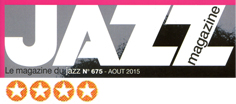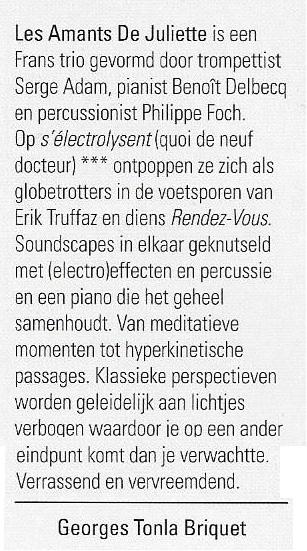Les Amants de Juliette s'électrolysent |
 Jazzmagazine n° 675 Août 2015 Jazzmagazine n° 675 Août 2015 |
Nouveauté. Cela fait à présent plus de vingt ans que ce trio pour le moins original essaime ses opus, celui-ci étant le sixième (si mon compte est bon). Comme le titre l'indique, nos Amants ont décidé de tromper leur monde en mettant un temps le purement acoustique au placard pour faire entrer le traitement numérique en temps réel par la fenêtre afin de favoriser encore davantage l'interaction et le développement / déploiement d'une texture sonore extrêmement subtile. Pour autant, jamais le trio ne recourt aux boucles ou aux séquences – pour un usage « bio » des outils numériques. Les pièces alternent / oscillent entre ambient, groove bancals, à-plats…toujours avec une grande liberté poétique. Si l'improvisation et l'interaction se trouvent au centre de leur intérêt, on sent que l'écrit a bien sa part, notamment au moment de conclure chacune des six pièces qui composent l'album (à taille humaine, donc). L'ombre de Don Cherry, Jon Hassel, parfois celle de Sun Ra (solo de clavier sur La disparition du sable), traînent ici ou là au-dessus des tablas de Foch, mais comme un arrière-fond historique qui ne vampirise en rien l'extrême originalité du propos. Quoi de neuf Docteur ? Que du bel et bon ! Ludovic Florin |
« L’électrolyse est une méthode qui permet de réaliser des réactions chimiques grâce à une activation électrique. C’est le processus de conversion de l’énergie électrique en énergie chimique. »... selon Wikipedia. Serge Adam et ses deux complices diplômés de facultés créatives indéniables ne manquent pas de méthode et leurs molécules musicales interagissent dans un esprit très proche des seventies : énergie électrique maîtrisée ! Miles n’est jamais bien loin, en dilution homéopathique. THIERRY GIARD
Enregistré en février 2015 à
Montreuil, France
|
04/10/2015
|
C’est dans un même esprit d’ambiance électrique que le trio des Amants
de Juliette s’ouvre aux musiques du monde. L’électricité n’y est plus urbaine
mais va puiser à des sources intemporelles. En ce sens c’est un peu comme s’il
y avait fusion entre l’esprit de Miles Davis et celui de Don Cherry mais avec
une approche fondamentalement moderne. Comme dans le cas de Bob Belden, le trio
cherche ici les espaces, les grands espaces. Cherche les juxtapositions des
nappes dans une sorte de voyage sonore auquel contribue l’apport évident des
tablas de Philippe Foch. Il y a une forme de complémentarité évidente entre les
trois musiciens animés chacun par une réelle personnalité musicale différente
et pourtant symbiotique. Ça joue à très haut niveau dans tout ce que le trio
permet de combinaison différente. Là où Belden puise dans un jazz électrique,
le trio porte ce même jazz aux confins du monde porté par des mélismes
orientaux, des incises, des mélange acoustiques et électroniques. Les trois
s’en donnent à cœur joie, un peu comme de géniaux chercheurs pour s’affranchir
de toutes barrières stylistiques et tenter tout ce qui leur passe par la tête
comme sur ce morceau où Delbecq que l’on attend électrique mais qui pourtant
s’empare du piano pour jouer sur un contraste fascinant.
|
Juliette a bien de la chance. Trois amants pareils… Qui, en plus, s’électrolysent. Ça doit être encore mieux que la seule électricité. Le jazz comme passage de l’électrique au chimique, quelque chose en plus. À la naissance du trio, en 94, ils n’avaient pas tâté de la fée Électricité. Cette fois, tout le monde est branché, non pas à la mode geek bien sûr. L’électron reste aussi libre que la note, et la machine demeure asservie à l’instrument, et celui-ci à son artiste. C’est heureux. Comme si souvent dans le jazz d’aujourd’hui, la prise de risques oscille entre « tradition et modernité ». Un cliché qui recouvre parfois une consistante réalité. Les Amants de Juliette piochent leur inspiration à la fois dans les musiques traditionnelles et dans l’aventure moderne. Il y a de l’Afrique dans les polyrythmies. Il y a de l’Indonésie dans les pointes de timbales, de l’Inde dans les jeux de tablas et dans le piano préparé comme un tampura. Mais l’électronique embarquée transcende le tout, avec une vraie discrétion. Les percussions de Philippe Foch n’ont plus d’âge. Surtout quand elles s’unissent aux harmoniques de Benoît Delbecq. Le premier a séjourné plusieurs fois à Calcutta. Le deuxième, matheux comme un acousticien, s’est frotté à Cage et à Ligeti, autant qu’aux Coleman, Ornette et Steve. Le défi était autre, à cet égard, pour Serge Adam dont la trompette se trouve guettée au coin du bois de Miles. Comment ne pas risquer l’ornière de « In a Silent Way » – entre autres ? Pari gagné, ô combien ! Les Amants sont à la fête, virevoltent joyeusement, nous font voyager dans le jazz et dans le monde comme dans un grand tout musiqué et coloré. Une vraie réussite. par Gérard Ponthieu // P.-S. : Au fait, si mes souvenirs sont bons, l’heureuse Juliette qui a donné son nom au trio n’est autre que la fille de Serge Adam. Compliments à tous ! |
Publié le 15 novembre 2015 |
|
Les
Amants de Juliette c’est le trio de Serge Adam (trompette et électronique)
Benoit Delbecq (claviers) et Philippe Foch (percussions et électronique) et ça fait bien 20 ans que le trio existe, et ça se sent à l’évidente osmose de
jeu entre les trois ; et si ce dernier disque est plus électrique |
Les Amants De Juliette - S'Electrolysent (Quoi De Neuf, Docteur, 2015) ***½ By Stef
|
Friday, July 31, 2015 |
by Jan Hocek 2015 |
Francouzský avantgardní trumpetista a elektronik Serge Adam byl čtenářům JazzPortu představen vloni na jaře. S jedním ze svých trií, LES AMANTS DE JULIETTE, natočil již šesté album. Zove se „Les Amants de Juliette´s électrolysent“ a nyní jej vydal na své značce Quoi de neuf docteur… |
JAZZ OP DE PLAAT |
|
Benoît Delbecq 3 Ink Clean Feed CF 340 CD Les
amants de Juliette s’électrolysent Quoi de neuf docteur Doc 079
Recording for more than a quarter
century, French pianist Benoît Delbecq has made a point to divide his skills
between conventional and unconventional sessions and various-sized ensembles.
Close listening to these sets though suggests that the trio nay be his perfect
formation. In the right hands and using appropriately flexible instrumentation,
a sufficient number of colors are coupled with economy of form. At the same
time, like the proper organization of a spread sheet, there’s enough space
remaining so that each of the participants has room to amply express his
participation.
The sixth CD by the all-Gallic Les amants de Juliette (LAdJ) – origin or reason for this female’s friendship unknown – S’électrolysent eposes the relationship among Delbecq’s keyboards, the vocalized trumpeting of Serge Adam and a juddering undertow from Philippe Foch’s percussion. Foch’s preference for tabla rhythms is non- specific enough to take advantage of the drums’ echoing qualities without touching Carnatic exotica, though. Taking a cue from the improv-orientation of early fusion – Eddie Henderson or Miles Davis variants – the trio also relies on electronics, but as accents for the six original compositions. Ink is resin of a different color. LAdJ band members take their cues from bedrock fusion, subsequently interpolating more contemporary tones as if they’re social media and anti-pollution devices outfitted in a classic car. Meanwhile to take the automobile metaphor further, Delbecq own trio is the 2016 model of the emblematic jazz piano trio. Adding preparations to his piano confirms Delbecq’s up-to-date orientation. Ink’s defining timbres are the plucks, twangs and stops that emanate from the piano’s excited inner strings. This isn’t overdone though, since Delbecq uses outside and inner piano effects with an Ahmad Jamal-like prudence. Consolidating each musician’s parts, a composition such as the introductory “Le Ruisseau” bubbles like the stream it’s meant to reflect. As this recital of all-Delbecq compositions evolves, the others make their presence felt as well. Canadian bassist Miles Perkin displays an erudite use of guitar-like chording on “Colle Et Acrylique” for instance, which is further glued together with some Latin-directed cymbal clapping from French percussion Emile Biayenda and sweeping keyboard glissandi. With the strength of a weightlifter achieving his personal best, the bassist sets up the title track with extended string swots that open up the piece to tremolo coloration from Delbecq plus relaxed patterning from Biayenda. Similarly, tunes such as “Nombre” and “Family Trees” are perfect reflections of this trio’s artistry. Understated bass lines and an insistence on linear narrative on the pianist’s part reflect back to the slow-burning, beneath-the-surface swing that was second-nature to Jazz trios of the 1950s and 1960s. But at the same time, cunning and caressing key patterning and unexpected sonic alleyway exploration confirm that the BD3 is more than your father’s Jazz combo. Precise, stabbing lines from piano and double bass characterize “L’Esprythme”, which is dedicated to Adam and another band in which Delbecq and the trumpeter are involved. Another point of congruence to LAdJ is how the pianist’s bolstered string preparations in trio form relate to Foch’s tabla work on the other CD. On that set, like an anthropologist familiar with the links among indigenous cultures, the percussionist ensures that none of his beats are ethnically specific. In fact rhythms on “Ashan” appear to have Latin, Balkan or Klezmer roots. Other pieces which are more closely aligned to the Indian subcontinent don’t express so-called exotica via the drummer though. Instead Delbecq’s keyboard undulations and vibrations or in the case of “Ashan”, pulsating emphasis from his bass pedal provide the sp-called ethnic sounds. With archeological-like skill of isolating treasured fragments from the detritus that surround them, Adam’s vocalized brass often sound as if it’s processed through a hoary echoplex. These collective loops and echoes allow him to outline ideas at the proper pace and capacity. Chirping tremolos erupt from the middle of electric washes on a tune like the concluding “La disparition du Sable”. Elsewhere secluded grace notes burst into fuller bloom like nurtured hothouse flowers on “Naoto” since processing means that Adam can bulk up his solos with additional, affiliated tones. The most complex, if expected, use of electronics is on “Family Trees”. Here the high-pitched reverberations are segmented among different signals so that Adam at points appears to be playing more than one trumpet. Sometimes in this contrapuntal expression, he appears to be completing a statement initially advanced by the brass instrument. Delbecq and Foch respond with an appropriately splayed interface. On the evidence of these top-flight CDs, Delbecq continues to improve and display his skills as leader and as part of closely knit ensembles. Who knows in what form or grouping his talent will next be displayed? —Ken Waxman Track Listing: S’électrolysent: 1. Maps 2. Djengo 3. Ashan 4. Naoto 5. Family Trees 6. La disparition du Sable Personnel: S’électrolysent: Serge Adam (trumpet and electronics); Benoît Delbecq (keyboards, samplers and bass station) and Philippe Foch (tablas, percussion and electronics) Track Listing: Ink: 1. Le Ruisseau 2. Ronchamp 3. Three Clouds 4. Nombre 5. Colle Et Acrylique 6. L’Esprythme 7. Family Trees 8. Figures 9. Ink 10. Hemisphère Sud Personnel: Ink: Benoît Delbecq (piano and prepared piano); Miles Perkin (bass) and Emile Biayenda (drums and percussion)
|
|
|
 |